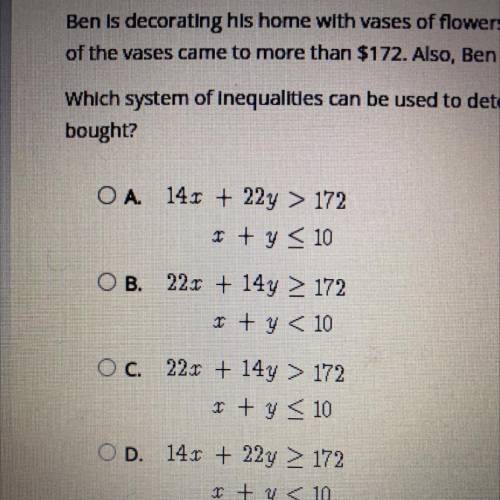
Mathematics, 09.10.2021 07:20 mrashrafkotkaat
Ben is decorating his home with vases of flowers. He bought glass vases that cost $22 each and ceramic vases that cost $14 each. The total cost
of the vases came to more than $172. Also, Ben bought no more than 10 vases in all.
Which system of inequalities can be used to determine the number of glass vases, x, and the number of ceramic vases, y, that Ben could have
bought?
Help please


Answers: 3


Other questions on the subject: Mathematics

Mathematics, 21.06.2019 16:30, Zayo1337
An airport in death valley is 60 feet below sea level, and an airplane is flying 2,000 feet above sea level. how many feet must the plane descend in order to land? a. 2060 b. 2000 feet c. 1940 feet d. 1880 feet e.1400 feet will mark as brainliest
Answers: 2

Mathematics, 21.06.2019 18:00, leianagaming
Describe the relationship between the angles of similar triangles and the sides of similar triangles
Answers: 1

Mathematics, 21.06.2019 21:30, baltazmapa629n
The length of a field is 100 yards and its width is 75 yards. if 1 inch represents 25 yards, what would be the dimensions of the field drawn on a sheet of paper?
Answers: 1

Mathematics, 21.06.2019 21:30, gonzalezashley152
In a test for esp (extrasensory perception), the experimenter looks at cards that are hidden from the subject. each card contains either a star, a circle, a wave, a cross or a square.(five shapes) as the experimenter looks at each of 20 cards in turn, the subject names the shape on the card. when the esp study described above discovers a subject whose performance appears to be better than guessing, the study continues at greater length. the experimenter looks at many cards bearing one of five shapes (star, square, circle, wave, and cross) in an order determined by random numbers. the subject cannot see the experimenter as he looks at each card in turn, in order to avoid any possible nonverbal clues. the answers of a subject who does not have esp should be independent observations, each with probability 1/5 of success. we record 1000 attempts. which of the following assumptions must be met in order to solve this problem? it's reasonable to assume normality 0.8(1000), 0.2(1000)%30 approximately normal 0.8(1000), 0.2(1000)% 10 approximately normal srs it is reasonable to assume the total number of cards is over 10,000 it is reasonable to assume the total number of cards is over 1000
Answers: 1
You know the right answer?
Ben is decorating his home with vases of flowers. He bought glass vases that cost $22 each and ceram...
Questions in other subjects:


Mathematics, 20.11.2019 22:31

Mathematics, 20.11.2019 22:31


Biology, 20.11.2019 22:31







